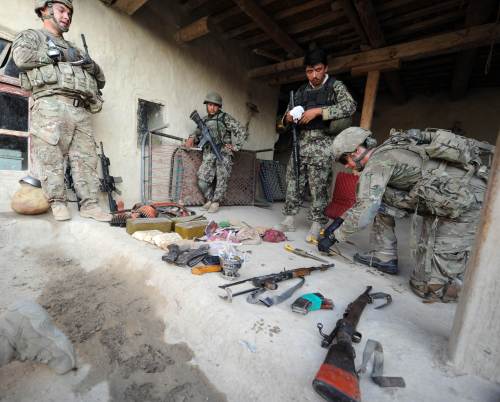U.S. president to announce blueprint on withdrawal of troops, handover of power
WASHINGTON (AP) ― President Barack Obama will announce the critical next steps in America’s decade-long war in Afghanistan on Wednesday, outlining both a plan to start bringing thousands of U.S. troops home next month and a broader withdrawal blueprint aimed at giving Afghans control of their own security in 2014.
But even as Obama finalizes those plans, there are divisions in his administration, with military leaders favoring only a gradual reduction in troops but other advisers advocating a significant decrease in the coming months.
Administration officials say Obama is still working through the details on how many troops will start leaving Afghanistan in July, his self-imposed deadline for beginning the drawdown.
He is considering a range of options presented to him last week by Gen. David Petraeus, the top U.S. and NATO commander in Afghanistan.
“He’s finalizing his decision. He’s reviewing his options,” White House spokesman Jay Carney said Monday.
Obama is expected to make Wednesday’s announcement in Washington.
On Thursday, he will visit troops at Fort Drum, the upstate New York military base that is home to the 10th Mountain Division, one of the most frequently deployed divisions to Afghanistan and Iraq.
While much of the attention is focused on how many troops will leave Afghanistan next month, the more telling aspects of Obama’s decision center on what happens after July, particularly how long the president plans to keep the 30,000 surge forces he sent in 2009 in the country.
There is a growing belief that the president must at least map out the initial withdrawal of the surge troops when he addresses the public.
But whether those forces should come out over the next eight to 12 months or slowly trickle out over a longer time is hotly debated.
Military commanders want to keep as many of those forces in Afghanistan for as long as possible, arguing that too fast a withdrawal could undermine the fragile security gains in the fight against the Taliban insurgency in Afghanistan, the al-Qaida training ground for the Sept. 11 attacks.
WASHINGTON (AP) ― President Barack Obama will announce the critical next steps in America’s decade-long war in Afghanistan on Wednesday, outlining both a plan to start bringing thousands of U.S. troops home next month and a broader withdrawal blueprint aimed at giving Afghans control of their own security in 2014.
But even as Obama finalizes those plans, there are divisions in his administration, with military leaders favoring only a gradual reduction in troops but other advisers advocating a significant decrease in the coming months.
Administration officials say Obama is still working through the details on how many troops will start leaving Afghanistan in July, his self-imposed deadline for beginning the drawdown.
He is considering a range of options presented to him last week by Gen. David Petraeus, the top U.S. and NATO commander in Afghanistan.
“He’s finalizing his decision. He’s reviewing his options,” White House spokesman Jay Carney said Monday.
Obama is expected to make Wednesday’s announcement in Washington.
On Thursday, he will visit troops at Fort Drum, the upstate New York military base that is home to the 10th Mountain Division, one of the most frequently deployed divisions to Afghanistan and Iraq.
While much of the attention is focused on how many troops will leave Afghanistan next month, the more telling aspects of Obama’s decision center on what happens after July, particularly how long the president plans to keep the 30,000 surge forces he sent in 2009 in the country.
There is a growing belief that the president must at least map out the initial withdrawal of the surge troops when he addresses the public.
But whether those forces should come out over the next eight to 12 months or slowly trickle out over a longer time is hotly debated.
Military commanders want to keep as many of those forces in Afghanistan for as long as possible, arguing that too fast a withdrawal could undermine the fragile security gains in the fight against the Taliban insurgency in Afghanistan, the al-Qaida training ground for the Sept. 11 attacks.

There are also concerns about pulling out a substantial number of U.S. forces as the heightened summer fighting season gets under way.
Retiring Defense Secretary Robert Gates has said he believes the initial drawdown should be “modest.”
But other advisers are backing a more significant withdrawal that starts in July and proceeds steadily through the following months.
That camp believes the slow, yet steady, security gains in Afghanistan, combined with the death of Osama bin Laden and U.S. success in dismantling much of the al-Qaida network in the country give the president an opportunity to make larger reductions this year.
There is also growing political pressure on Capitol Hill for a more significant withdrawal. 27 senators, Democrats as well as Republicans, sent Obama a letter last week pressing for a shift in Afghanistan strategy and major troop cuts.
“Given our successes, it is the right moment to initiate a sizable and sustained reduction in forces, with the goal of steadily redeploying all regular combat troops,” the senators wrote.
“The costs of prolonging the war far outweigh the benefits.”
There is broad public support for starting to withdraw U.S. troops.
According to an Associated Press-GfK poll last month, 80 percent of Americans say they approve of Obama’s decision to begin withdrawal of combat troops in July and end U.S. combat operations in Afghanistan by 2014.
Just 15 percent disapprove.







![[KH Explains] How should Korea adjust its trade defenses against Chinese EVs?](http://res.heraldm.com/phpwas/restmb_idxmake.php?idx=644&simg=/content/image/2024/04/15/20240415050562_0.jpg&u=20240415144419)










![[Today’s K-pop] Stray Kids to return soon: report](http://res.heraldm.com/phpwas/restmb_idxmake.php?idx=642&simg=/content/image/2024/04/16/20240416050713_0.jpg&u=)